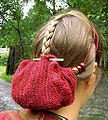Hairnet
A hairnet is a mostly elastic net-shaped headgear that is used to hold the hair in place. As an alternative to the headscarf , hairnets are used for health and safety reasons . Particularly with long hair, fixation is necessary for certain activities. Thus, the hair net prevents the ingress of hairs in a drilling machine and the consequent scalping the scalp. A hairnet is also worn for hygienic or medical reasons or as a headdress .
history
In Northern Europe, hairnets in jumping technique from the women's grave of Skrydstrup are already from the 15th / 14th centuries. Proven century BC, more recent finds of hairnets from the 8th to 5th centuries BC on the bog bodies Frau von Haraldskær and Frau von Arden from Denmark. Evidence for wearing hairnets was also found for ancient Greece. There are other finds from a garbage pit at the Roman military camp Vindonissa in Switzerland. Hairnets are also known from Roman women's graves. Their use in the early Middle Ages is attested in the Saxon cemetery of Liebenau in the 6th century AD.
Hairnets made of fine silk have existed in Germany and England since the 13th century . Hairnets made from knotted real hair were also popular; they could be used to inconspicuously hold hair of the same color in shape.
In 1971, a broad socio-political discussion in the Federal Republic of Germany established itself in the hairnet decree of the Federal Ministry of Defense, which liberalized the hairstyle regulations for male Bundeswehr soldiers.
Reconstruction of the hairnet of the bog body Frau von Arden from Denmark.
Web links
- Literature on hairnet in the catalog of the German National Library
- Magistra Nicolaa de Bracton: Netting for Hairnets (knotting hairnets, articles with pictures)
Individual evidence
- ^ Margrethe Hald: Ancient Danish Textiles from Bogs and Burials National Museum of Denmark, Copenhagen 1980 (page 245 ff .: Sprang)
- ↑ gold hairnet. Golden hairnet, illustration. Archived from the original on April 15, 2008 ; accessed on January 9, 2016 .
- ↑ Constanze Lösch: "Internationally networked" - the second Roman pompous hairnet from the Rhineland . In: Archeology in the Rhineland . 2011, p. 120-122 .
- ↑ Broadcast on Deutschlandfunk on the subject



